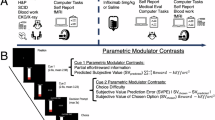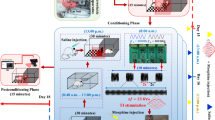Abstract
To understand and exploit centrally acting drugs requires reliable measures of their time course of action in the human brain. Functional magnetic resonance imaging (fMRI) is able to measure noninvasively, drug-induced changes in task-related brain activity. Here, we have characterized, in a specific region of the brain, the time of onset of action and the half-life of action of a clinically relevant dose of a potent opioid analgesic agent, remifentanil. These times were established from the temporal variation of the amplitude of the blood oxygen level-dependent response in the insular cortex contralateral to a painfully hot thermal stimulus, in volunteers receiving a remifentanil infusion. The insular cortex has repeatedly been reported as activated by noxious thermal stimulation. The times of onset and offset of drug action were each characterized by a half-life for changes in fMRI signal from within the insula. These characteristic times agreed with the observed drug-induced analgesia and previous pharmacokinetic–pharmacodynamic measurements for remifentanil. We have successfully measured, for the first time using fMRI, temporal pharmacological parameters for a CNS-active drug based on its effect on task-related activity in a specific brain region. Comparison of the time course of regional brain activity with pain perception could reveal those regions engaged in drug-induced analgesia.
Similar content being viewed by others
Log in or create a free account to read this content
Gain free access to this article, as well as selected content from this journal and more on nature.com
or
References
Babenco HD, Conard PF, Gross JB (2000). The pharmacodynamic effect of a remifentanil bolus on ventilatory control. Anesthesiology 92: 393–398.
Bannister PR, Jenkinson M (2001). Robust affine motion correction in fMRI time series. Neuroimage 13: S70.
Becerra LR, Breiter HC, Stojanovic M, Fishman S, Edwards A, Comite AR et al (1999). Human brain activation under controlled thermal stimulation and habituation to noxious heat: an fMRI study. Magn Reson Med 41: 1044–1057.
Bloom AS, Hoffmann RG, Fuller SA, Pankiewicz J, Harsch HH, Stein EA (1999). Determination of drug-induced changes in functional MRI signal using a pharmacokinetic model. Hum Brain Mapp 8: 235–244.
Breiter HC, Gollub RL, Weisskoff RM, Kennedy DN, Makris N, Berke JD et al (1997). Acute effects of cocaine on human brain activity and emotion. Neuron 19: 591–611.
Burton H, Videen TO, Raichle ME (1993). Tactile-vibration-activated foci in insular and parietal-opercular cortex studied with positron emission tomography: mapping the second somatosensory area in humans. Somatosens Mot Res 10: 297–308.
Coull JT, Nobre AC, Frith CD (2001). The noradrenergic α2 agonist clonidine modulates behavioural and neuroanatomical correlates of human attentional orienting and alerting. Cerebral Cortex 11: 73–84.
Craig AD, Chen K, Bandy D, Reiman EM (2000). Thermosensory activation of insular cortex. Nat Neurosci 3: 184–190.
Egan TD (1995). Remifentanil pharmacokinetics and pharmacodynamics. A preliminary appraisal. Clin Pharmacokinet 29: 80–94.
Egan TD, Minto CF, Hermann DJ, Barr J, Muir KT, Shafer SL (1996). Remifentanil versus alfentanil: comparative pharmacokinetics and pharmacodynamics in healthy adult male volunteers. Anesthesiology 84: 821–833.
Egan TD, Minto CF, Lemmens HJ, Muir KT, Hermann D, Shafer SL (1994). Remifentanil versus alfentanil: comparative pharmacodynamics. Anesthesiology 81: A374.
Forman SD, Cohen JD, Fitzgerald M, Eddy WF, Mintun MA, Noll DC (1995). Improved assessment of significant activation in functional magnetic resonance imaging (fMRI): use of a cluster-size threshold. Magn Reson Med 33: 636–647.
Friston KJ, Worsley KJ, Frackowiak RS, Maziotta JC, Evans AC (1994). Assessing the significance of focal activations using their spatial extent. Hum Brain Mapp 1: 214–220.
Furey ML, Pietrini P, Haxby JV (2000). Cholinergic enhancement and increased selectivity of perceptual processing during working memory. Science 290: 2315–2319.
Glass PS, Hardman D, Kamiyama Y, Quill TJ, Marton G, Donn KH et al (1993). Preliminary pharmacokinetics and pharmacodynamics of an ultra-short-acting opioid: remifentanil (GI87084B). Anesth Analg 77: 1031–1040.
Gray JM, Kenny GN (1998). Development of the technology for ‘Diprifusor’ TCI systems. Anaesthesia 53: 22–27.
Hariri AR, Mattay VS, Tessitore A, Fera F, Smith WG, Weinberger DR (2002). Dextroamphetamine modulates the response of the human amygdala. Neuropsychopharmacology 27: 1036–1040.
Hermann DJ, Egan TD, Muir KT (1999). Influence of arteriovenous sampling on remifentanil pharmacokinetics and pharmacodynamics. Clin Pharmacol Ther 65: 511–518.
Hoke JF, Cunningham F, James MK, Muir KT, Hoffman WE (1997). Comparative pharmacokinetics and pharmacodynamics of remifentanil, its principle metabolite (GR90291) and alfentanil in dogs. J Pharmacol Exp Ther 281: 226–232.
Honey GD, Bullmore ET, Soni W, Varatheesan M, Williams SC, Sharma T (1999). Differences in frontal cortical activation by a working memory task after substitution of risperidone for typical antipsychotic drugs in patients with schizophrenia. Proc Natl Acad Sci USA 96: 13432–13437.
Hughes MA, Glass PS, Jacobs JR (1992). Context-sensitive half-time in multicompartment pharmacokinetic models for intravenous anesthetic drugs. Anesthesiology 76: 334–341.
Jenkinson M, Smith S (2001). A global optimisation method for robust affine registration of brain images. Med Image Anal 5: 143–156.
Jensen MP, Karoly P (2001). Self Report Scales and Procedures for Assessing Pain in Adults. In: Turk DC, Elzack R (eds). Handbook of Pain Assessment. Guildford Press: New York. pp 15–34.
Johansen-Berg H, Christensen V, Woolrich M, Matthews PM (2000). Attention to touch modulates activity in both primary and secondary somatosensory areas. Neuroreport 11: 1237–1241.
Johansen-Berg H, Matthews PM (2002). Attention to movement modulates activity in sensori-motor areas, including primary motor cortex. Exp Brain Res 142: 13–24.
Jones AK, Brown WD, Friston KJ, Qi LY, Frackowiak RS (1991a). Cortical and subcortical localization of response to pain in man using positron emission tomography. Proc R Soc Lond B Biol Sci 244: 39–44.
Jones AK, Friston KJ, Qi LY, Harris M, Cunningham VJ, Jones T et al (1991b). Sites of action of morphine in the brain. Lancet 338: 825.
Jones AK, Qi LY, Fujirawa T, Luthra SK, Ashburner J, Bloomfield P et al (1991c). In vivo distribution of opioid receptors in man in relation to the cortical projections of the medial and lateral pain systems measured with positron emission tomography. Neurosci Lett 126: 25–28.
Kapila A, Glass PS, Jacobs JR, Muir KT, Hermann DJ, Shiraishi M et al (1995). Measured context-sensitive half-times of remifentanil and alfentanil. Anesthesiology 83: 968–975.
Kimberg DY, Aguirre GK, Lease J, D'Esposito M (2001). Cortical effects of bromocriptine, a D-2 dopamine receptor agonist, in human subjects, revealed by fMRI. Hum Brain Mapp 12: 246–257.
Kleinschmidt A, Bruhn H, Kruger G, Merboldt KD, Stoppe G, Frahm J (1999). Effects of sedation, stimulation, and placebo on cerebral blood oxygenation: a magnetic resonance neuroimaging study of psychotropic drug action. NMR Biomed 12: 286–292.
Leslie RA, James MF (2000). Pharmacological magnetic resonance imaging: a new application for functional MRI. Trends Pharmacol Sci 21: 314–318.
Lorenz IH, Kolbitsch C, Schocke M, Kremser C, Zschiegner F, Hinteregger M et al (2000). Low-dose remifentanil increases regional cerebral blood flow and regional cerebral blood volume, but decreases regional mean transit time and regional cerebrovascular resistance in volunteers. Br J Anaesth 85: 199–204.
Malizia AL, Gunn RN, Wilson SJ, Waters SH, Bloomfield PM, Cunningham VJ et al (1996). Benzodiazepine site pharmacokinetic/pharmacodynamic quantification in man: direct measurement of drug occupancy and effects on the human brain in vivo. Neuropharmacology 35: 1483–1491.
Mattay VS, Callicott JH, Bertolino A, Heaton I, Frank JA, Coppola R et al (2000). Effects of dextroamphetamine on cognitive performance and cortical activation. Neuroimage 12: 268–275.
Minto CF, Schnider TW, Egan TD, Youngs E, Lemmens HJ, Gambus PL et al (1997a). Influence of age and gender on the pharmacokinetics and pharmacodynamics of remifentanil. I. Model development. Anesthesiology 86: 10–23.
Minto CF, Schnider TW, Shafer SL (1997b). Pharmacokinetics and pharmacodynamics of remifentanil. II. Model Application. Anesthesiology 86: 24–33.
Pappata S, Tavitian B, Traykov L, Jobert A, Dalger A, Mangin JF et al (1996). In vivo imaging of human cerebral acetylcholinesterase. J Neurochem 67: 876–879.
Patel SS, Spencer CM (1996). Remifentanil. Drugs 52: 417–427.
Petrovic P, Kalso E, Petersson KM, Ingvar M (2002). Placebo and opioid analgesia– imaging a shared neuronal network. Science 295: 1737–1740.
Peyron R, Garcia-Larrea L, Gregoire MC, Costes N, Convers P, Lavenne F et al (1999). Haemodynamic brain responses to acute pain in humans: sensory and attentional networks. Brain 122: 1765–1780.
Peyron R, Laurent B, Garcia-Larrea L (2000). Functional imaging of brain responses to pain. A review and meta-analysis (2000). Neurophysiol Clin 30: 263–288.
Shargel L, Yu ABC (1999). Applied Biopharmaceutics and Pharmacokinetics. Appleton and Lange: Stamford.
Smith S, Bannister PR, Beckmann C, Brady JM, Clare S, Flitney D et al (2001). FSL: new tools for functional and structural brain image analysis. Neuroimage 13: S249.
Stein EA (2001). FMRI: a new tool for the in vivo localization of drug actions in the brain. J Anal Toxicol 25: 419–424.
Stein EA, Pankiewicz J, Harsch HH, Cho JK, Fuller SA, Hoffmann RG et al (1998). Nicotine-induced limbic cortical activation in the human brain: a functional MRI study. Am J Psychiatry 155: 1009–1015.
Talbot JD, Marrett S, Evans AC, Meyer E, Bushnell MC, Duncan GH (1991). Multiple representations of pain in human cerebral cortex. Science 251: 1355–1358.
Thiel CM, Henson RN, Dolan RJ (2002). Scopolamine but not lorazepam modulates face repetition priming: a psychopharmacological fMRI study. Neuropsychopharmacology 27: 282–292.
Thiel CM, Henson RNA, Morris JS, Friston KJ, Dolan RJ (2001). Pharmacological modulation of behavioural and neuronal correlates of repetition priming. J Neurosci 21: 6846–6852.
Tracey I (2001). Prospects for human pharmacological functional magnetic resonance imaging (phMRI). J Clin Pharmacol 41: 21S–28S.
Tracey I, Becerra L, Chang I, Breiter H, Jenkins L, Borsook D et al (2000a). Noxious hot and cold stimulation produce common patterns of brain activation in humans: a functional magnetic resonance imaging study. Neurosci Lett 288: 159–162.
Tracey I, Hicks G, Rogers R, Clare S, Bountra C, Barrington P et al (2000b). Pharmacological modulation of the central pain response. Proc Intl Soc Mag Reson Med 8: 913.
Wagner KJ, Willoch F, Kochs EF, Siessmeier T, Tolle TR, Schwaiger M et al (2001). Dose-dependent regional cerebral blood flow changes during remifentanil infusion in humans: a positron emission tomography study. Anesthesiology 94: 732–739.
Wise RG, Rogers R, Painter D, Bantick S, Ploghaus A, Williams P et al (2002). Combining fMRI with a pharmacokinetic model to determine which brain areas activated by painful stimulation are specifically modulated by remifentanil. Neuroimage 16: 999–1014.
Woolrich M, Ripley B, Brady JM, Smith S (2001). Temporal autocorrelation in univariate linear modelling of fMRI data. Neuroimage 14: 1370–1386.
Worsley KJ, Evans AC, Marrett S, Neelin P (1992). A three-dimensional statistical analysis for CBF activation studies in human brain. J Cereb Blood Flow Metab 12: 900–918.
Acknowledgements
We acknowledge the generous support of The Dr Hadwen Trust for Humane Research, The Wellcome Trust (RGW, Advanced Training Fellowship Grant Code 067037/Z/02/Z), GlaxoSmithKline (PW), UK Medical Research Council and Higher Education Funding Council (IT).
Author information
Authors and Affiliations
Corresponding author
Rights and permissions
About this article
Cite this article
Wise, R., Williams, P. & Tracey, I. Using fMRI to Quantify the Time Dependence of Remifentanil Analgesia in the Human Brain. Neuropsychopharmacol 29, 626–635 (2004). https://doi.org/10.1038/sj.npp.1300364
Received:
Revised:
Accepted:
Published:
Issue date:
DOI: https://doi.org/10.1038/sj.npp.1300364
Keywords
This article is cited by
-
Polymorphism in the µ-opioid receptor gene (OPRM1) modulates neural processing of physical pain, social rejection and error processing
Experimental Brain Research (2015)



